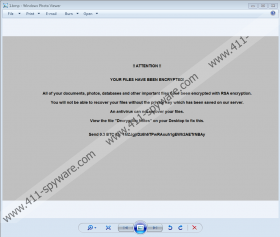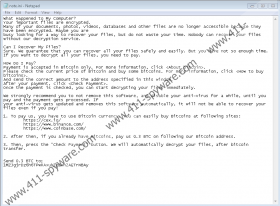Jest Ransomware Removal Guide
Jest Ransomware does not care about your virtual privacy or your personal files. If it gets the chance to invade your operating system, it does that instantly. Usually, that is done using spam emails, unreliable installers, and RPD vulnerabilities. Then, it quickly encrypts files, which is a process of ciphering files to make then unreadable without a decryption/private key. Even though the attackers behind this infection should have the power to decrypt your personal files, they are unlikely to exercise it. All they care about is money, and while they are likely to promise you to restore your files after you pay them a certain sum of money, they are likely to disappear without a trace. Obviously, if you have not paid the ransom yet, we suggest that you do not do it. If you have paid it, do not think that a mistake has happened and that you need to repeat the payment. The only thing you need to do is delete Jest Ransomware, and if read our report and also use the included removal tips, we are sure that you will succeed.
Have you noticed the “.jest” extension appended to the corrupted files first? Most likely, you learned about the invasion of this malware via two specific files. One of them is called “1.bmp,” and it changes the Desktop background image to deliver a message. According to it, your files were encrypted, and now you need to pay a ransom of 0.3 Bitcoin to 1MZJgjrDz6h6TPwRAxuh1gEWh2AETrNBAy (attackers’ Bitcoin wallet address). The message also points to “Decryption Notes” on the Desktop. This refers to a file named “README - Decryption Note.lnk,” which is a shortcut of another file called “note.ini.” You can find Jest Ransomware files in the %ALLUSERSPROFILE% directory and also on the Desktop. All of them require removal, but it is most important to delete an .exe file with a random name because the threat can auto-start with Windows, which means that the file could restart encryption process every time you restart your computer. Of course, you might hesitate to perform removal due to the message represented via the .lnk file.
The Jest Ransomware ransom note file dropped on the Desktop is meant to reassure you that you can get all files restored as soon as you pay the ransom. Well, 0.3 Bitcoin is a lot of money. It can be anywhere from 2,500 or 3,000 USD. Do you have that kind of money? Even if you do, you should not give in and pay the ransom. As we mentioned earlier, the attackers will take the payment, but they will not give you anything in return for it. Therefore, if you do as told, you will find yourself without files and without money. Hopefully, you do not need to rely on cyberattackers at all. That is possible if you have copies of the corrupted files. If you do, you do not need to purchase bitcoins, send them to the attackers, and then cross your fingers and hope for a miracle. All you have to do is remove Jest Ransomware and then replace the corrupted files with copy versions. Even if you end up losing everything now, you will create new files in the future, and you must create copies of them because Jest is not the only file encryptor out there. In fact, there are thousands upon thousands of them, including Revon Ransomware, Npsk Ransomware, or Lezp Ransomware.
Hopefully, you know what to do about your personal files that were corrupted by Jest Ransomware. Whether or not you can replace them, we hope that you do not need to take risks set up by cybercriminals. To remove this malicious infection, you can either choose to follow the instructions below, or you can implement a trusted anti-malware tool to do the job automatically. If you are choosing to follow the guide below, make sure that you erase every single component and that you also scan your system afterward to check for leftovers or other undiscovered infections. If you are not ready to take on such a task, we recommend installing trusted anti-malware software. It will automatically remove Jest Ransomware and also secure your system to keep file-encryptors and other kinds of malware away.
How to delete Jest Ransomware
- Go to the Desktop.
- Delete files named Decryptor.lnk and README - Decryption Note.lnk.
- Launch Run (tap Windows+R keys) and enter regedit into the dialog box.
- In Registry Editor, go to HKLM\SOFTWARE\Microsoft\Windows\CurrentVersion\Run.
- Find the ransomware value (could be named VYCWMR), check the name of the .exe file it is linked to (value data: C:\ProgramData\{unknown name}.exe), and then Delete it.
- Launch Explorer (tap Windows+E keys) and then enter %ALLUSERSPROFILE% into the field at the top.
- Delete the files named 1.bmp, {unknown name}.exe (the one linked to the value), chk.dat, encryptedfiles.eco, MSWINSCK.OCX, note.ini, recover.exe, and rps.exe.
- Empty Recycle Bin to complete the Jest Ransomware removal processes.
- Install a genuine malware scanner to inspect your system for leftovers. If threats are found, delete them.
Jest Ransomware Screenshots:



